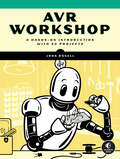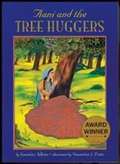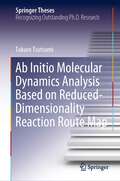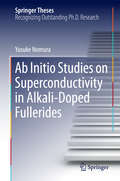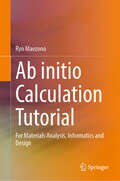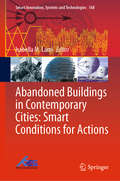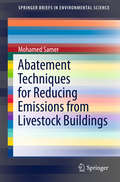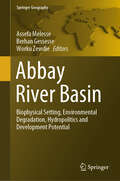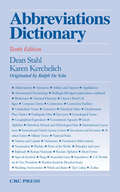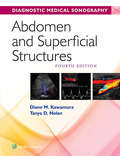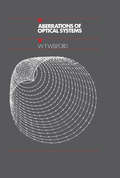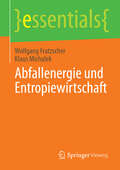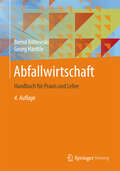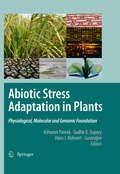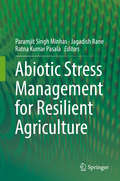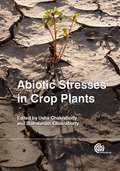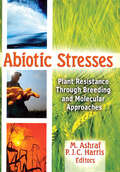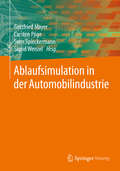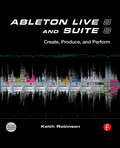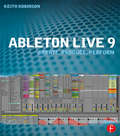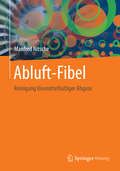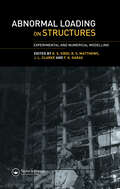- Table View
- List View
AVR Workshop: A Hands-On Introduction with 60 Projects
by John BoxallBuild more than 55 hands-on, wide-ranging projects with the popular and versatile AVR family of microcontrollers.AVR Workshop is a comprehensive introduction to working with the Microchip AVR 8-bit family of microcontrollers – made famous through their use in Arduino and other compatible boards. Whether you&’re an absolute beginner or longtime electronics enthusiast, this book gives you the latest coding and hardware knowledge required to build over 55 projects. After the author guides you through the basic C programming skills you need to work directly with ATmega328P-PU and ATtiny85 microcontrollers, your operation will be up and running. You&’ll go from building blinking LEDs and handling various types of user input, to creating real-time clocks, digital thermometers, and even controlling small motorized devices.
Aani & the Tree Huggers
by Jeannine AtkinsBased on true events in India in the 1970s, young Aani and the other women in her village defend their forest from developers by wrapping their arms around the trees, making it impossible to cut them down.
Aaron Klug A Long Way from Durban
by Holmes Kenneth C.The atomic structures of macromolecules provide the key to understanding how life works. Aaron Klug led the way in the development of methods for solving such structures and is one of the pioneers of structural molecular biology. He was awarded a Nobel Prize in 1982 for his work. Illuminating both his personal life and scientific achievements, this unique biography begins with Klug's youth in Durban and his studies at Johannesburg, Cape Town and then Trinity College, Cambridge. Holmes proceeds to explore Klug's career from his work on the structure of viruses with Rosalind Franklin at Birkbeck College, London to his time as Director of the MRC Laboratory of Molecular Biology (LMB) in Cambridge and as President of the Royal Society. Drawing on their long-term collaboration, interviews and unique access to Klug's archives, Holmes provides a fascinating account of an innovative man and his place in the history of structural molecular biology.
Ab Initio Molecular Dynamics Analysis Based on Reduced-Dimensionality Reaction Route Map (Springer Theses)
by Takuro TsutsumiThis thesis proposes useful tools, on-the-fly trajectory mapping method and Reaction Space Projector (ReSPer), to analyze chemical reaction mechanisms by combining the reaction route map and the ab initio molecular dynamics. The key concept for the proposed tools is the Cartesian distance between pairwise molecular structures, and a practical procedure to get the optimal distance is introduced. The on-the-fly trajectory mapping method tracks the distance function between reference structures and molecular structures along the trajectory. Although this method provides fruitful insight into dynamic reaction behaviors, the visualization of reaction routes into a low-dimensional space is still challenging because of the multi-dimensionality. ReSPer successfully constructs a low-dimensional reaction space defined by mathematically-selected principal coordinates representing mutual distance relationships in the full-dimensional space. ReSPer also enables us to project trajectories into the reaction space in the reduced dimension. In this thesis, these methods are applied to several reactions, including bifurcating and photochemical reactions, revealing dynamically-allowed reaction mechanisms. This thesis provides robust and versatile tools to elucidate dynamical reaction routes on the basis of the reduced-dimensionality reaction route map and will help control chemical reaction dynamics and select descriptors for machine learning.
Ab Initio Studies on Superconductivity in Alkali-Doped Fullerides (Springer Theses)
by Yusuke NomuraThis book covers high-transition temperature (Tc) s-wave superconductivity and the neighboring Mott insulating phase in alkali-doped fullerides. The author presents (1) a unified theoretical description of the phase diagram and (2) a nonempirical calculation of Tc. For these purposes, the author employs an extension of the DFT+DMFT (density-functional theory + dynamical mean-field theory). He constructs a realistic electron-phonon-coupled Hamiltonian with a newly formulated downfolding method. The Hamiltonian is analyzed by means of the extended DMFT. A notable aspect of the approach is that it requires only the crystal structure as a priori knowledge. Remarkably, the nonempirical calculation achieves for the first time a quantitative reproduction of the experimental phase diagram including the superconductivity and the Mott phase. The calculated Tc agrees well with the experimental data, with the difference within 10 K. The book provides details of the computational scheme, which can also be applied to other superconductors and other phonon-related topics. The author clearly describes a superconducting mechanism where the Coulomb and electron-phonon interactions show an unusual cooperation in the superconductivity thanks to the Jahn-Teller nature of the phonons.
Ab initio Calculation Tutorial: For Materials Analysis, Informatics and Design
by Ryo MaezonoThis textbook covers the framework of first-principles analysis applied to materials using density functional theory (DFT). It provides a set of hands-on tutorials using the Quantum ESPRESSO package, an open-source software for DFT. The tutorials are well chosen, designed for maximum effectiveness while requiring a minimum of the reader’s time, and the book describes how the essential components are combined to create the practical applications based on the idea of modeling practical problems of materials. The book carefully explains how to prepare the platform to run the tutorials assisted by free software. This textbook is useful for students in experimental laboratories, for industrial researchers, and for those not majoring in theoretical studies but learning individually.
Abandoned Buildings in Contemporary Cities: Smart Conditions for Actions (Smart Innovation, Systems and Technologies #168)
by Isabella M. LamiIs it possible to energise the reuse of urban abandoned spaces with low financial capital investment? Addressing this question requires a normative and cultural change, where the rules are less focused on the material processes of producing space and more aimed at fostering the construction of relationships. The reality of several European cities shows how traditional forms of stimulating urban renewal – with respect to the financing of operations, how to design and build, and urban planning legislation – no longer work. This book examines an alternative culture of design and regulation, drawing on the richness of the various approaches to the subject to present an integrated study of the phenomenon of reuse across its economic, architectural and urban dimensions. From this theoretical base, it empirically analyses six Italian case studies in terms of the broadness of geography and in their governance models, and of the important role of the unity of cultural destination for their reuse proposal. The book is intended for all those involved in the cultural challenge of reusing urban abandoned spaces, including public administrators, entrepreneurs, architects, planners and academics.
Abatement Techniques for Reducing Emissions from Livestock Buildings (SpringerBriefs in Environmental Science)
by Mohamed SamerThis book identifies future scientific research priorities for developing emissions inventories, emissions abatement techniques and mitigation strategies in order to improve and sustain livestock production that is in line with climate change adaptation. Livestock production is a major source of atmospheric pollutants and greenhouse gases, such as methane, nitrogen oxides, carbon dioxide and ammonia, all of which directly contribute to global warming and climate change. Air pollutant emissions from agricultural practices have a negative environmental impact and are of relevant political importance, as highlighted in both the Kyoto and Gothenburg Protocols. This book provides solutions on how to abate these emissions by using effective abatement techniques such as additives, manure storage covers, aerobic and anaerobic treatments, and dietary manipulation. Each chapter in the book provides valuable, up-to-date information on abatement techniques, thus allowing the reader to better understand the issues involved. Recent advances and new perspectives in the field are also discussed.
Abbay River Basin: Biophysical Setting, Environmental Degradation, Hydropolitics and Development Potential (Springer Geography)
by Assefa Melesse Berhan Gessesse Worku ZewdieThe book focuses on the Abbay Basin biophysical setting, the status of natural resources and degradation processes, agricultural practices, environmental resource conservation efforts, and the role of Earth observation and geospatial technologies in monitoring and planning for the wise utilization of natural resources under severe land resource degradation and climate change. It provides a collection of techniques and syntheses from the perspectives of geospatial science and technology application dimensions as well as legal and sociopolitical circumstances. It utilizes comprehensive data, algorithms, methods, and tools to produce and disseminate high-quality information for the Abbay Basin. It also produces empirical data and knowledge on what has been done thus far regarding the application of EO data and geospatial technologies for sustainable utilization of natural resources in the Abbay Basin and synthesizes previous studies to develop strong and consolidated information on the basin. The book will also have distinct outlooks on the purpose and contribution of satellite imagery and geospatial data as well as improved analytics for basin-wide resource management.
Abbreviations Dictionary (Routledge Revivals)
by Dean A. Stahl Karen LandenPublished in 2001: Abbreviations, nicknames, jargon, and other short forms save time, space, and effort - provided they are understood. Thousands of new and potentially confusing terms become part of the international vocabulary each year, while our communications are relayed to one another with increasing speed. PDAs link to PCs. The Net has grown into data central, shopping mall, and grocery store all rolled into one. E-mail is faster than snail mail, cell phones are faster yet - and it is all done 24/7. Longtime and widespread use of certain abbreviations, such as R.S.V.P., has made them better understood standing alone than spelled out. Certainly we are more comfortable saying DNA than deoxyribonucleic acid - but how many people today really remember what the initials stand for? The Abbreviations Dictionary, Tenth Edition gives you this and other information from Airlines of the World to the Zodiacal Signs.
Abdomen and Superficial Structures: Diagnostic Medical Sonography (Diagnostic Medical Sonography Series)
by Diane Kawamura Tanya NolanKawamura’s Nolan Diagnostic Medical Sonography: Abdomen and Superficial Structures,4th Edition provides an up-to-date, comprehensive, and consistent treatment of abdominal sonography. And is an integral part of the updated Diagnostic Medical Sonography Series, which includes new editions of Diagnostic Medical Sonography: Abdomen and Superficial Structures, Diagnostic Medical Sonography: Obstetrics and Gynecology, and Diagnostic Medical Sonography: The Vascular System, provides the right content at the right level for the right way to teach and learn.
Abdominal Ultrasound for Surgeons
by Ellen J. Hagopian Junji MachiAbdominal Ultrasound for Surgeons provides a comprehensive guide to the use of ultrasonography in surgical practice of abdominal diseases. The content is divided into three major sections, with the final section being dedicated to the logistics of incorporating ultrasound into a surgical practice. In Part I : The Basics, the principles of ultrasonography are reviewed focusing on ultrasound physics, equipment and instrumentation. A detailed approach to the various scanning methods with image and artifact interpretation is demonstrated with illustrations and images. In Part II : Anatomy, Application and Intervention, ultrasound anatomy and its use in surgery are detailed. The normal and abnormal ultrasound anatomy of specific abdominal organ or organ systems (esophagus, liver, pancreas, biliary, stomach, anorectum, vascularabdominal wall) with illustrations and images are demonstrated. A state-of-the-art review of the major applications of surgical abdominal ultrasound is provided in this section ranging from trauma ultrasound and laparoscopic staging to techniques in ultrasound guidance and three-dimensional targeting. In Part III : Ultrasound in Surgical Practice, the practical aspects of incorporation of ultrasound into a surgical practice are addressed with topics ranging from credentialing to coding and billing. Abdominal Ultrasound for Surgeons will serve as a very useful resource and guide for surgeons and students with little to some experience in ultrasound, including practicing surgeons, surgical fellows and surgical residents.
Aberrations of Optical Systems
by W.T WelfordAlthough the subject of optical design as a branch of applied physics is over one hundred years old, the use of aberration theory has changed considerably. Aberrations of Optical Systems covers elementary optics and aberration theory of various optical systems, including the use of nonaxially symmetric systems and diffractive optical elements in complex designs, such as head-up displays and the increasing use of scanning systems with laser illumination. The book provides the complete range of mathematical tools, formulae, and derivations needed for understanding the process of optical design and for planning optical design programs. While the treatment is mainly based on geometrical optics, some excursions into physical optics are made, particularly in connection with the problems of optical tolerances.
Abfallenergie und Entropiewirtschaft (essentials)
by Wolfgang Fratzscher Klaus MichalekEs wird eine allgemein gültige Definition der Abfallenergie vorgeschlagen. Diese erfordert die Einbeziehung des II. Hauptsatzes der Thermodynamik. Das Auftreten von inneren Nichtumkehrbarkeiten bei allen technischen Prozessen als wesentliche, in den Energiebilanzen nicht sichtbare Verlustquellen führt zu äußeren Verlusten, den Abfallenergien. Die betrachteten Systeme zeigen den Einfluss von Technologie und Bilanzgrenzen auf Art und Größe der Verluste und den Zusammenhang zwischen Primärenergiebilanz, anthropogenen Prozessen und Abfallenergie. So stellt sich die Abfallenergieverwertung als die duale Seite einer allgemeinen energiewirtschaftlichen Betrachtung dar. Wenn man von einem solchen Ansatzpunkt ausgeht, spricht man nach einem Paradigmenwechsel bei der Gestaltung optimaler technischer Prozesse von einer Entropiewirtschaft statt einer Energiewirtschaft.
Abfallwirtschaft: Handbuch für Praxis und Lehre
by Bernd Bilitewski Georg HärdtleIn bewährter Weise beantwortet dieses Standardwerk alle Fragen der täglichen Praxis zum Thema Abfall. Für die Neuauflage haben die Autoren das gesamte Werk auf den neuesten Stand gebracht: die rechtlichen Grundlagen, Angaben zu Abfallmengen und -zusammensetzung, zur Sammlung, zum Umschlag und Transport, zu Recycling und Kosten von Abfallbehandlungsanlagen wurden aktualisiert. Außerdem wurde der Band um eine Zusammenfassung der aktuellen Entwicklungen im Bereich Stoffstrommanagement und um das Thema automatische Sortierung erweitert.
Abiotic Stress Adaptation in Plants: Physiological, Molecular and Genomic Foundation
by Hans J. Bohnert Ashwani Pareek Govindjee S. K. SoporyEnvironmental insults such as extremes of temperature, extremes of water status as well as deteriorating soil conditions pose major threats to agriculture and food security. Employing contemporary tools and techniques from all branches of science, attempts are being made worldwide to understand how plants respond to abiotic stresses with the aim to help manipulate plant performance that will be better suited to withstand these stresses. This book on abiotic stress attempts to search for possible answers to several basic questions related to plant responses towards abiotic stresses. Presented in this book is a holistic view of the general principles of stress perception, signal transduction and regulation of gene expression. Further, chapters analyze not only model systems but extrapolate interpretations obtained from models to crops. Lastly, discusses how stress-tolerant crop or model plants have been or are being raised through plant breeding and genetic engineering approaches. Twenty three chapters, written by international authorities, integrate molecular details with overall plant structure and physiology, in a text-book style, including key references.
Abiotic Stress Management for Resilient Agriculture
by Paramjit Singh Minhas Jagadish Rane Ratna Kumar PasalaThis book offers a state-of-the-art overview of on abiotic stresses in terms of the challenges; scope and opportunities; copping strategies for adaptation and mitigation using novel tools for building resilience in agricultural crops and livestock; as well as for policy implementation. Divided into four major parts: advances and prospects for understanding stress environments; adaptation and mitigation options; crop-based mitigation strategies; and mitigation options in animal husbandry, the book focuses on problem-solving approaches and techniques that are essential for the medium to long-term sustainability of agricultural production systems The synthesis and integration of knowledge and experiences of specialists from different disciplines offers new perspectives in the versatile field of abiotic stress management, and as such is useful for various stakeholders, including agricultural students, scientists, environmentalists, policymakers, and social scientists.
Abiotic Stresses in Crop Plants
by Usha Chakraborty Bishwanath ChakrabortyThis book is based to a great extent on the biochemical and molecular mechanisms of tolerance of commonly encountered abiotic stresses in nature. This book will deal with increasing temperature, water, salinity, and heavy metals and ozone, and how these abiotic stresses can be managed by microbes through their alleviation mechanisms. Water stress includes both drought and flooding. 1st section outlines the relevance of abiotic stresses in present day environmental conditions. The 2nd section deals with three major stresses - temperature, water and salinity and the metabolic changes and protective adjustments in plants for withstanding these stresses. The 3rd section deals with the role of heavy metals and ozone. The final section is devoted to general abiotic stresses and their alleviation by microbes. These offer a cost-effective and eco-friendly means of combating different stresses.
Abiotic Stresses: Plant Resistance Through Breeding and Molecular Approaches
by M. Ashraf P. J. C. HarrisGain a better understanding of the genetic and physiological bases of stress response and stress tolerance as part of crop improvement programsAbiotic Stresses: Plant Resistance Through Breeding and Molecular Approaches explores innovative methods for breeding new varieties of major crops with resistance to environmental stresses that l
Ablaufsimulation in der Automobilindustrie
by Sven Spieckermann Sigrid Wenzel Gottfried Mayer Carsten PögeDas vorliegende Buch stellt den Stand der Technik zur Ablaufsimulation in der deutschen Automobilindustrie zusammen und beschreibt Simulationsanwendungen in einzelnen Gewerken sowie auf Lieferkettenebene. Ferner werden Standards zur Simulation aus dem Verein Deutscher Ingenieure (VDI) und dem Verband der Automobilindustrie (VDA) aufgegriffen sowie aktuelle Entwicklungen rund um die Digitale Fabrik und Industrie 4.0 diskutiert. Autoren aus Forschung, Automobilindustrie und Automobilzulieferindustrie sowie aus Simulationsdienstleistungsunternehmen stellen Aktualität, Praxisrelevanz, wissenschaftliche und fachliche Breite sowie die Berücksichtigung unterschiedlicher Perspektiven sicher.Die ereignisdiskrete Simulation (auch Ablaufsimulation) wird in der Automobilindustrie fast durchgängig in allen Gewerken zur Untersuchung von Produktions- und Logistikprozessen eingesetzt. Mit ihrer Hilfe kann die Planung von Produktions- und Logistiksystemen umfassend abgesichert und nachvollzogen werden. Aufgrund der zunehmenden Komplexität, Flexibilität und Wandlungsfähigkeit dieser Systeme bei gleichzeitiger Verkürzung der Planungszeiträume hat sich in den letzten Jahren die Relevanz der Ablaufsimulation als Analysemethode kontinuierlich erhöht. Mit der Etablierung eines Simultaneous Engineering, der Einführung von Werkzeugen zur Digitalen Fabrik oder der Beherrschung neuer Herausforderungen im Zusammenhang mit den Bestrebungen von Industrie 4.0 unterliegt auch die Simulation neuen Entwicklungen. Das Buch wendet sich an Anwender, Forscher und Studierende in gleichem Maße.
Ableton Live 8 and Suite 8: Create, Produce, Perform
by Keith Robinson Huston SingletaryLearn how to create, produce and perform a whole new way; prepare to unlock the power of Live. This book and DVD combination shows, if you get it right, exactly what Ableton Live can deliver.Engineered to follow Lives non linear music environment the book looks and feels like the program, its unique format utilizes the terms and creative features of Live- tabs, keys, pointers, and labels to learn the littlest things that make the biggest difference.Packed with professional testimonials, concepts, definitions, hundred of tips and tricks and hidden features the book covers the software's nuts and bolts and creative technique to create, produce, perform and make music on the fly.The accompanying DVD contains ?Live sets? and web pointer information to sync and download as well as interviews, further hints and tips and video
Ableton Live 9: Create, Produce, Perform
by Keith RobinsonNever has there been music production software that so closely emulates the human mind and the demand for delivering music through a computer than Live. With an imaginative design and a forward-thinking mission, Ableton continues their legacy with Live 9, a software package that drives music production to the cutting edge while squarely meeting the needs of the composer, producer, perform, songwriter, DJ, and beyond. With such a progressive approach to its development, some of you may feel a bit disoriented or even intimidated at first sight of Live’s unconventional design, especially those of you coming from a traditional Digital Audio Workstation (DAW) background. If you are new to DAWs, DJ style programs, or software music production in general, then you’ll soon be right at home with the "parallel concept" of Live’s Session and Arrangement Views. For the rest of you, you’ll have to rethink your approach to composing, arranging and producing music just a bit; but it will be a worthwhile adjustment. That is why this book has been written: to help reinvent the experienced software-based music producer and to unleash the new user. The goal here is to build and cultivate a strong understanding of Live 9’s concepts and to provide material that will engage all DAW users alike. With this goal in mind, at the end of each reading you should feel that your current skills and knowledge base have been elevated to the next level. For the current Ableton Love user – yes, you - there is plenty here to unlock! After all, there is still a little "new user" inside us all. Now it is time to learn how to Create, Produce and Perform with Live 9 – all you have to do is decide what your needs are, because it’s all here. First published in 2013. Routledge is an imprint of Taylor & Francis, an informa company.
Abluft-Fibel: Reinigung lösemittelhaltiger Abgase
by Manfred NitscheDieses Fachbuch beschreibt welches Verfahren zur Abluftreinigung f#65533;r Sie das Richtige ist. Zun#65533;chst wird die indirekte und direkte Kondensation, sowie die Membrananreicherung mit Kondensation erl#65533;utert. Die weiteren Kapitel besch#65533;ftigen sich mit der Absorption der L#65533;semittel in geeigneten Waschfl#65533;ssigkeiten, der Regeneration des Waschmittels und geben Auskunft #65533;ber Adsorptionsverfahren mit Dampf,- Inertgas-, und Vakuumdesorption. Der abschlie#65533;ende Beitrag behandelt die thermische und biologische Entsorgung.
Abläufe verbessern - Betriebserfolg garantieren (ifaa-Edition)
by Institut für angewandte ArbeitswissenschDer Leitfaden »Abläufe verbessern – Betriebserfolg garantieren« unterstützt Führungskräfte und Mitarbeiter, Verbesserungen betrieblicher Abläufe im Alltag erfolgreich voranzutreiben und nachhaltig zu sichern. Ziele sind, den Wertschöpfungsanteil betrieblicher Abläufe stetig zu erhöhen und Verschwendung in den Produktions- und Arbeitssystemen des gesamten Unternehmens zu erkennen und zu vermeiden. Die Grundlagen hierfür sind eine klar strukturierte Vorgehensweise und die konsequente Nutzung von Zahlen, Daten und Fakten. Die Vorgehensweise berücksichtigt erfolgsrelevante Elemente bewährter Verbesserungsmethoden – wie Six Sigma, PDCA-Zyklus, 8-D Report, REFA-Planungssystematik u. a. – in pragmatischer Form. Zu den einzelnen Arbeitsschritten sind bewährte Werkzeuge in direkt anwendbarer Form verfügbar. Anschauliche Beispiele aus der Praxis ergänzen das Angebot. Seit der ersten Auflage dieses Leitfadens im Jahre 2008 haben zahlreiche Unternehmen die im Leitfaden beschriebene Vorgehensweise erfolgreich umgesetzt. Die Anwender bestätigten den Mehrwert des Leitfadens sowie ihre positiven Erfahrungen und Ergebnisse in einer begleitenden Befragung.
Abnormal Loading on Structures: Experimental and Numerical Modelling
by J. L. Clarke F. K. Garas K. S. Vird R. S. MatthewsDesigning for hazardous and abnormal loads has become an important requirement in the design process of most major buildings and civil engineering structures, ranging from tall buildings to bridges, power plants to harbour and coastal installations. This state-of-the-art volume was compiled by the Institution of Structural Engineers' informal study
